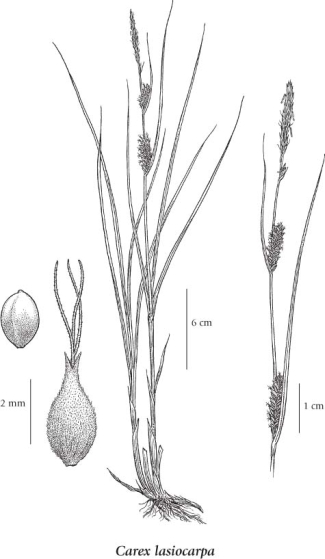Carex lasiocarpa Ehrh.
slender sedge (woollyfruit sedge)
Cyperaceae (Sedge family)
Introduction to Vascular Plants
slender sedge (woollyfruit sedge)
Cyperaceae (Sedge family)
Introduction to Vascular Plants
Species Information click to expand contents
General:
Perennial, loosely tufted herb from long, creeping rhizomes; stems 30-120 cm tall, arising singly or a few together, shorter than the leaves, wine-red at the bases.
Leaves:
Sheaths tight, cross-wrinkled, yellowish- to brownish-tinged, the lowest ones breaking into threads; blades 2 to 5 per stem, flat at the bases, strongly in-rolled above, borne on the lower 3/4 of the stem, 1-2 mm wide, the lower ones reduced; ligules short, thick, as long as wide.
Flowers:
Spikes 3 to 5, the terminal 2 (sometimes 1) linear, 1-2.5 cm long, long-stalked, with many male flowers, the lower 2 or 3 spikes cylindrical, with female flowers, unstalked to short-stalked, erect; bracts subtending the lowest spike leaflike, sheathless or short-sheathing, the lowest usually longer than the inflorescence.
Fruits:
Perigynia egg-shaped to nearly globe-shaped, 2.8-4.5 mm long, 1.8-2 mm wide, dull brownish-green, somewhat inflated, densely soft-hairy, the numerous ribs obscured, the bases round, short-stalked, the beaks 0.8-1.2 mm long, deeply bidentate, the teeth 0.3-0.7 mm long; female scales lanceolate to narrowly egg-shaped, long-pointed or awned, more or less fringed, narrower and slightly longer to shorter than the perigynia, purplish-brown, with 3-nerved, green centres, with dull, narrow, translucent margins; stigmas 3; achenes 3-angled, with concave sides and blunt angles, smooth, 1.5-2 mm long.
Notes:
North American plants have been treated as ssp. americana (Hitchcock et al. 1969, Boivin 1992). Koyama (1962), Hermann (1970), Egorova (1999) and others consider our material to be identical to that in Eurasia.
Illustration click to expand contents

If more than one illustration is available for a species (e.g., separate illustrations were provided for two subspecies) then links to the separate images will be provided below. Note that individual subspecies or varietal illustrations are not always available.
Illustration Source: The Illustrated Flora of British Columbia
Ecology click to expand contents
Ecological Framework for Carex lasiocarpa
The table below shows the species-specific information calculated from
original data (BEC database) provided by the BC Ministry of Forests and Range.
(Updated August, 2013)
The table below shows the species-specific information calculated from
original data (BEC database) provided by the BC Ministry of Forests and Range.
(Updated August, 2013)
| Site Information |
Value / Class |
||
|
Avg |
Min |
Max |
|
| Elevation
(metres) |
910 | 45 | 1905 |
| Slope
Gradient (%) |
0 | 0 | 84 |
|
Aspect (degrees) |
192 | 86 | 335 |
| Soil
Moisture Regime (SMR) [0 - very xeric; 4 - mesic; 8 - hydric] |
7 | 3 | 8 |
| Modal
Nutrient Regime
Class |
C | ||
| #
of field plots species was recorded in: |
321 | ||
| Modal
BEC Zone Class |
ICH | ||
|
All BEC Zones (# of stations/zone) species was recorded in |
BAFA(1), BG(1), BWBS(11), CDF(16), CWH(66), ESSF(9), ICH(67), IDF(51), MS(23), PP(1), SBPS(21), SBS(46), SWB(1) | ||
|
Source:
Klinkenberg 2013
|
|||
Habitat and Range click to expand contents
Bogs, swamps, shorelines, marshes and fens in the lowland, steppe and montane zones; frequent in S BC south of 56degreeN, rare northward, absent on N Vancouver Island, the Queen Charlotte Islands and adjacent mainland; circumpolar, N to AK, YT and NT, E to NF and S to MA, VA, OH, IN, IL, IA, NE, CO, UT, ID and CA; Eurasia.